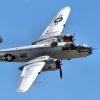calsfoundation@cals.org
B-25 Bomber Crash of 1948
During a period of about three months in the winter of 1947 and 1948, Arkansas was the site of the crash of two military planes on routine flights. On November 17, 1947, a B-25 crashed into Mount Magazine in Logan County, and on February 6, 1948, a B-25 crashed into Round Top Mountain near Jasper (Newton County). A total of eleven people died in the two crashes, with five dying in the 1948 crash.
On February 6, 1948, a B-25 bomber lifted off from Wright Field in Dayton, Ohio, en route to Little Rock (Pulaski County). The plane was scheduled to land in Little Rock a little after 8:00 p.m. When it did not arrive, calls were put out to determine its location. These calls provided no immediate answer.
At the time of its expected Little Rock arrival, the plane was flying over the Ozark Mountains in Newton County. Conditions were rainy, foggy, and cold, with some ice. At about 8:00 p.m., area citizens, including spectators at a local high school basketball game, heard the low-flying plane and then a loud explosion that shook the windows of many houses. About that same time, others reported a low-flying plane that appeared to be in distress. The plane, which was over fifty feet long, crashed about 200 feet from the northeastern summit of the approximately 1,858-foot-tall Round Top Mountain about two miles south of Jasper, just off Highway 7.
Law enforcement officials and citizens headed to the site. Newton County sheriff Russell Burdine and two Arkansas state troopers were some of the first to arrive on the scene, at about 10:00 p.m. However, due to the heat from the fire, which was described as “burning fiercely,” and a series of explosions, they were forced to move some distance away. Many others remained nearby to secure the site. Within a short time, military officials, headed by Major Samuel Williamson, arrived from Barksdale Air Force Base in Shreveport, Louisiana, and took charge of the crash site. Around midnight, when the fire had died down and explosions had ceased, it was determined safe to enter the site to search for survivors.
The devastation was immediately evident, with debris scattered over a 200-yard area. The sides of the mountain were blackened by the fire. One of the engines of the twin-engine plane was jammed into the mountain, with the second lying some 100 feet down the mountain. Fragments of the plane lay everywhere, with the largest fragment being the plane’s tail section. Interestingly, among all the debris was the “charred remains of the radio operators log book.” Examination of the log shed little light on the cause of the crash, however, other than one of the last entries reporting “icing conditions.”
Two military caps and captain bars were soon found. Within a short time, the remains of two bodies were recovered, with the remains of one “jammed behind the propeller blades.” All the victims’ bodies were described as “mangled.” The remains were delivered to the L. C. Holt Funeral Home in nearby Harrison (Boone County) by February 7.
The military quickly released the names of the three crew members and two passengers who had been on board. The pilot, First Lieutenant Phillip Novick of Brooklyn, New York, was an experienced World War II veteran pilot. His co-pilot was First Lieutenant Charles W. Thomas of Zephyrhills, Florida. The final member of the crew was crew chief Master Sergeant George L. Haties of Dayton, Ohio. The passengers were Naval Gunner Mate Second Class Francis Russell of Oakland, California, and First Lieutenant Felton F. Roberson of Osborne, Ohio. Roberson, a native of Little Rock and a 1940 graduate of Little Rock Catholic High School, had hitched a ride on the plane to visit his relatives. The remains of Novick, Roberson, and Thomas are marked by a single headstone in the Little Rock National Cemetery. Russell is buried in Madison, Ohio.
No official cause of the crash was determined, though it was suspected that icing conditions and fog were the most likely causes. Military officials determined that there was “no salvage value” to the plane, so what was left of the B-25 was left on the mountain, where it remains in the twenty-first century.
In 2001, the state of Arkansas established Round Top Mountain Park. Grants from the Arkansas Department of Transportation and Arkansas Recreational Trails provided for the construction of approximately four miles of trails. The trail has been designated as a part of White House Millennium Trails. A concrete block building, located at the trailhead, is used as an interpretive center. The crash site, still covered by the debris of the 1948 tragedy, was placed on the Arkansas Register of Historic Places on April 7, 2010.
For additional information:
“Bodies Taken from Plane Wreckage.” Arkansas Gazette, February 8, 1948, p. 10A.
Dunlap, J. E., Jr. “Five Charred Bodies Taken from Wreck.” Arkansas Democrat, February 8, 1948, p. 1.
“Five Die as Plane Hits Ozark Peak.” Arkansas Democrat, February 7, 1948, p. 1.
“Five Probably Killed When Plane Falls.” Arkansas Gazette, February 7, 1948, p. 1A.
“Round Top Mountain Crash Site.” Arkansas Register of Historic Places. https://www.arkansasheritage.com/arkansas-register/round-top-mountain-crash-site (accessed June 3, 2023).
“Round Top Mountain Hiking Trails.” AR Own Backyard. https://www.arownbackyard.com/2021/10/26/round-top-mountain-hiking-trails/ (accessed June 3, 2023).
Mike Polston
CALS Encyclopedia of Arkansas









Comments
No comments on this entry yet.